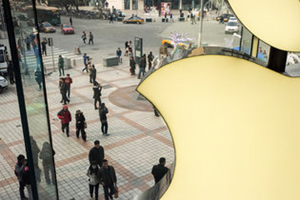
Your Money
Buybacks by
Companies Like Apple May Signal Danger, Not Growth
Strategies
By
JEFF SOMMER
JUNE
23, 2016
|

Apple’s sales have flagged and it has run into
trouble in China, where competition among smartphone makers has tightened.
But it has used billions of dollars of its cash on hand to buy back stock,
buoying its earnings per share.
Damir Sagolj/Reuters
|
IPhone
sales
are down and
Apple
has run into
obstacles
in
China,
its second-most-important market. Investors have beaten down Apple’s
once highflying shares this year, and the company’s troubles have been
a drag on the entire stock market.
But Apple and the stock market would
probably be in worse shape now if not for an important factor:
Companies like Apple have been buying billions of dollars’ worth of
their own shares at a record-breaking pace, returning money to
shareholders even as earnings lag.
This is
a bit of a puzzle because many studies have shown that using cash for
buybacks generally
doesn’t improve
a company’s operations or add to its intrinsic value. But spending
money on buybacks is much better than wasting it on money-losing
projects, when corporations don’t have other good uses for the cash.
And by reducing the number of shares on the market, buybacks make
earnings per share look better. That helps executives to big paydays
as they more easily reach their compensation targets, and it often
nudges up short-term share prices, returning money to rank-and-file
shareholders.
At the
moment, corporate America is sitting on an enormous cash hoard. Many
companies have been using the money in an epic share-buying spree —
one that has increased in intensity even as earnings have declined. In
the 12 months through March, operating earnings for the companies in
the Standard & Poor’s 500-stock index dropped to $854.9 billion from
$989 billion, but buybacks increased to $589 billion from $538.1
billion. That is the largest total for buybacks ever in a 12-month
period, according to a report from Howard Silverblatt, senior index
analyst at S&P Dow Jones Indices.
While Apple ranked
second in buybacks to Gilead Sciences in the first quarter, it has been the
undisputed king of buybacks over longer periods. Apple spent $36.8 billion on
buybacks in the 12 months through March, more than double the $16.6 billion
spent by
Microsoft,
the next-ranking company. And over the five years through March, Apple bought
back $116.6 billion worth of its own shares, followed by Microsoft with $45.7
billion, Pfizer with $44.9 billion and
Oracle with $43.7 billion.
A recent surge in
buybacks may have been stimulated by problems in the stock market, which fell
sharply at the beginning of the year. In the first quarter, Mr. Silverblatt
said, “the pace of buybacks was partially driven by companies supporting their
stock during the opening downturn.” More than three-fifths of the S.&P. 500
companies bought back at least some of their own shares in the quarter, he said,
and 139 bought enough over 12 months to reduce their share count by at least 4
percent.
|

An Apple store in Beijing. China is
the tech giant’s second-most-important market.
Gilles Sabrie for The New
York Times
|
|
As a matter of
simple math, reducing the number of shares by 4 percent will increase earnings
per share by 4 percent, too, and will tend to bolster short-term prices.
Buybacks are
playing an important role in the stock market. A Goldman Sachs report, relying
mainly on
Federal Reserve data,
found that to a startling degree, the buyback surge had made companies like
Apple their own most reliable investors. By funneling money into their own
shares, companies have been making up for a gap in demand from mutual funds,
foreigners, pension funds and individual Americans. In the first quarter of the
year, the Federal Reserve data showed net outflows from the American stock
market from these sources. But when corporate purchases of the companies’ own
shares were included, there was a net inflow of cash — providing a crucial
cushion for stock prices.
Buybacks are a
critical part of Goldman’s positive stock market outlook for the remainder of
2016: “We maintain our forecast that net buybacks will equal $450 billion in
2016 and remain the largest source of U.S. equity demand this year,” the company
said.
Low and even
negative interest rates resulting from the sluggish global economy and from the
expansionary monetary policies of the Federal Reserve and other central banks
have been enabling big corporations to borrow money cheaply, even when those
companies’ earnings have declined, and even when they have had no immediate
productive use for the funds.
In
March,
for example, when Apple told Wall Street that its iPhone sales had fallen, that
the Chinese market was proving more difficult than expected and that its
earnings had declined, it also said that it had more than $230 billion in cash
and equivalent securities. Most of that money is held overseas, where it is not
subject to immediate taxation by the Internal Revenue Service. Yet the company
has also been borrowing billions of dollars by issuing bonds denominated in
euros, yen and Swiss francs, enabling it to draw on an almost limitless
reservoir of funds. It hasn’t needed all of this money for research and
development, factories or even for mergers and acquisitions. Instead, it has
been funneling much of it to shareholders through buybacks and dividends.
Such maneuvers
often produce good results for stocks over the short term. Over longer periods,
however, unless earnings grow substantially, financial engineering like this
will take you only so far.
History tells us
that surges in buybacks are not always a sign of good things to come. It is
surely worth recalling what happened after American companies last set a
12-month buyback record. That was in December 2007, right before the worst
economic and stock market declines in recent history. Recall that the economic
setback known as the
Great
Recession
lasted from December 2007 through June 2009. And from December 2007 through
March 2009, the stock market lost almost half of its value. The last stock
buyback surge represented the high point of both economic and stock market
cycles, which endured brutal corrections.
For now, buyback
authorizations by American companies continue to increase, and there is so much
cash on hand that the current trend can easily continue for many months. At some
point, buybacks won’t be an elixir for share prices. They will be a symptom of
an overextended market.
A version of this article appears in print on June 26, 2016, on page
BU6 of the New York edition with the headline: Buyback Surge May
Signal Danger.
© 2016 The
New York Times Company